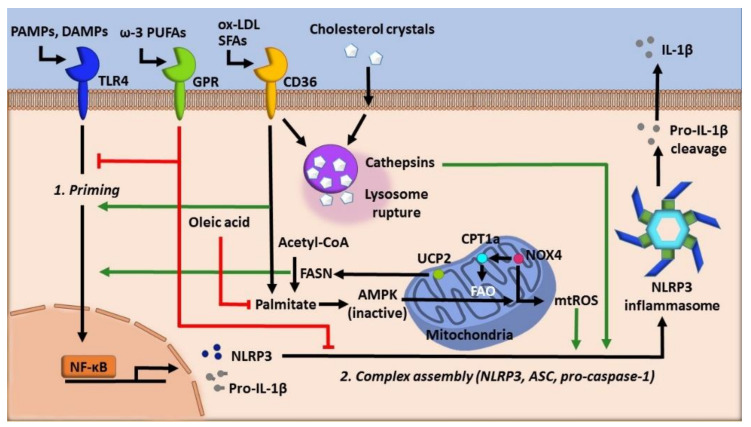Figure 3.
The role of lipids in regulating NLRP3 inflammasome. Lipid species are highly diverse and can either promote or inhibit NLRP3 inflammasome activity. Inflammasome priming, following the first hit, is promoted by both cholesterol crystals and the activity of fatty acid synthase (FASN) during fatty acid synthesis, whereas ω-3 polyunsaturated fatty acids (PUFA) such as docosahexaenoic acid (DHA) inhibit priming and inflammasome complex assembly via cell-surface receptors GPR120 and GPR40. Cholesterol crystals, oxidized LDL (ox-LDL), or saturated fatty acids (SFAs) can be internalized and form crystallized particles within lysosomes. Lipid crystallization can lead to lysosomal membrane rupture, which promotes NLRP3 activation in part by releasing cathepsins and enhancing mtROS production. The saturated fatty acid palmitate can also activate NLRP3 inflammasome by inactivating AMP-activated protein kinase (AMPK) and autophagy, leading to increased mtROS, whereas the monounsaturated oleic acid can inhibit this process. Finally, the fatty acid oxidation pathway promotes inflammasome activation via NADPH oxidase 4 (NOX4)-dependent upregulation of carnitine palmitoyltransferase 1a (CPT1a), likely through mtROS as well. Green lines denote the promotion of NLRP3 activity, whereas red lines denote the inhibition of NLRP3 inflammasome activity. DAMPs: danger-associated molecular patterns, FAO: fatty acid oxidation, GPR: G-protein coupled receptors, PAMPs: pathogen-associated molecular patterns, and UCP-2: mitochondrial uncoupling protein.

